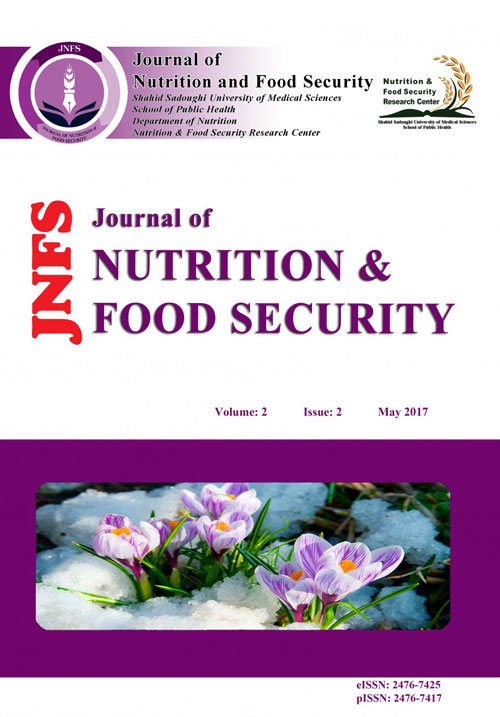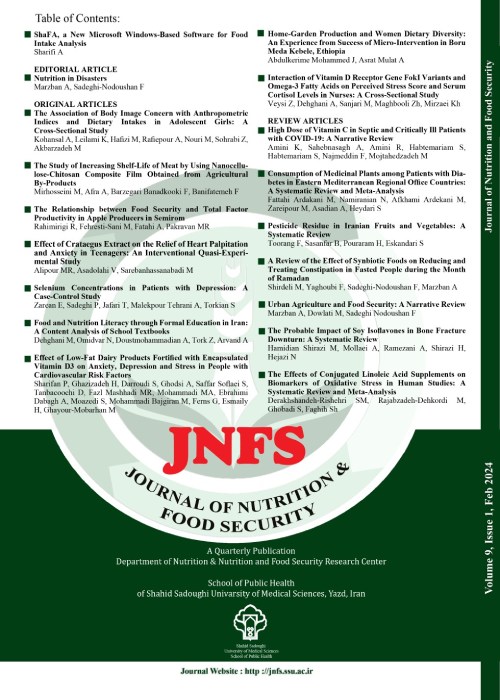فهرست مطالب

Journal of Nutrition and Food Security
Volume:2 Issue: 2, May 2017
- تاریخ انتشار: 1396/03/29
- تعداد عناوین: 8
-
Pages 135-137
-
Pages 141-148BackgroundThis descriptive study sought to assess the relation of anxiety, depression, and happiness with binge eating disorders (BED) among overweight and obese individuals.MethodsTo conduct this study, 200 individuals who referred to Nutrition Clinics in Isfahan, were selected randomly. They were asked to complete some questionnaires which were then scored according to Gormally scale. Respondents with scores of 17 and higher were selected as BED and entered the study. Final sample size consisted of 120 participants (28 men and 92 women). The management tools were Gormally et al.'s, the Oxford Happiness, Beck Depression Inventory, and the Kettel anxiety questionnaires.ResultsStatistical assessment consisted of descriptive statistics, pearson correlation coefficient, multiple regressions, and Fishers Z test. Results showed that BED had significant and linear correlations with depression (r = 0.51), happiness (r = 0.27), and anxiety ( r = 0.24) (all PConclusionsAnxiety and depression lead to over-eating and over-eating inturn reinforces both depression and anxiety.Keywords: Binge eating disorder, Happiness, Anxiety, Depression
-
Pages 149-156BackgroundSubstance abuse has significant impact on nutritional status. Due to the increased malnutrition during drug use and withdrawal, this study aimed at assessing the anthropometric indices in individuals referring to drug treatment centers in Qom.MethodsIn this descriptive-analytical study, 329 addicted individuals referring to addiction centers in Qom were randomly selected. A questionnaire was used with three parts including demographic characteristics, drug abuse history, and anthropometric indices including measurement of height, weight, waist circumference, arm circumference, and skinfold thickness in triceps and calf muscles.ResultsThe participants consisted of 328 men and only one woman, 29% of whom were in detoxification. The participant's mean age was 39.0 ± 7.1 years. The first and most-frequently used drug was opium. All anthropometric indices were associated with the consumption of opium substances and drug use was associated significantly with some parameters. With the exception of skinfold thickness in the calf, all the indices were affected by the type of consumed substances. The opium addicts had a higher body mass index compared with other drug users.ConclusionsDue to the importance of nutrition status in drug abuser's health and their lack of self-care, careful monitoring and evaluation of dietary intake, as well as nutrition status can play important roles in the rehabilitation of these individuals and help to prevent from reappearance of these habits.Keywords: Addiction, Anthropometric indices, Nutritional assessment, Heroin
-
Pages 157-163BackgroundImbalanced diet, as it may cause micronutrient malnutrition has been known as a causal factor for several chronic diseases. Several studies in Iran have shown that some micro-nutrient deficiencies are prevalent and of high concern. Minerals such as calcium and iron can supply physical and mental health as well as survival, and growth development. In this study, Nutrient density analysis was used to display Iranian household's diet quality.MethodsIn this descriptive-analytical study, the diet quality of seven provinces, namely Eastern Azarbaijan, Isfahan, Tehran, Khorasan, Khouzestan, Sistan Balochestan and Fars was assessed in terms of calcium and iron. To do so, the data were obtained through national household food consumption survey conducted by National Nutrition & Food Technology Research Institute, 2000-02, in Iran.ResultsGenerally, 80% of household's calcium density was less than the standard value and this rate was 40-70% for iron. Index of nutrition quality (INQ) for calcium and iron were respectively almost 1/2 and 1/3 of requirements in all provinces.ConclusionsThere were significant differences in calcium intake density between the rural and urban households however; there were no differences between the selective provinces and all over the country.Keywords: Calcium, Iron, Nutrient density, Diet
-
Pages 165-172BackgroundSexual dysfunction is an important health problem which prevalence in patients with type 2 diabetes (T2D) is higher than other people. The aim of this study was to evaluate the effect of L-arginine oral supplementation on sexual function in men with T2D and mild-to-moderate erectile dysfunction (ED).MethodsEighty men with T2D, suffering from mild-to-moderate erectile dysfunction participated in this double-blind clinical trial. They were randomly assigned in to two groups; receiving 5 g/day L-arginine (AG) or placebo group (PG) for 4 weeks. Sexual functions were recorded with international index of erectile function questionnaire at the beginning and end of the intervention. Total testosterone concentrations were measured too.ResultsThe total mean score of sexual function parameters significantly increased only in AG than PG (43.2 ± 6.2 vs. 39.4 ± 4.0, P = 0.003). Against PG, the mean of all parameters significantly improved in AG after intervention. Only the mean score of erectile function in AG had a significant increase compared to PG. Mean of other sexual activity scores between the two groups had no significant differences. The mean of testosterone concentration had a significant increase in both groups after the intervention, but the mean of changes was significantly higher in AG than in PG (1.91 μg/L vs. 0.53 μg/L, P = 0.004).ConclusionsThe present trial showed that daily consumption of 5 g L-arginine for four weeks in T2D men with mild-to-moderate sexual dysfunction improved various parameters such as erectile function, sexual satisfaction, sexual desire, pleasure from sexual intercourse, and testosterone level.Keywords: Arginine supplementation, Diabetes mellitus, Erectile dysfunction, Sexual dysfunction, Testosterone
-
Pages 173-178BackgroundObesity as the excessive accumulation of adipose in adipocytes has still remained equivocal. Since diets contain many components to prevent from or promote diseases, assessing effects of the whole diet on health can be more practical. The purpose of this study was to investigate the association between quality of diets through healthy eating index (HEI), and body composition parameters in Iranian adults.MethodsThis cross-sectional study included a total of 138 participants in the age range of 20-55 years, who referred to Endocrinology Center of Tehran University of Medical Sciences to receive health care services and fulfilled the eligibility criteria to participate in this study. Food frequency questionnaire (FFQ) was used to calculate HEI scores. Body composition data included: Fat mass (FM), fat free mass (FFM), abdominal fat (AF), muscle mass (MM), and total body water (TBW) that were collected by bioelectrical impedance instrument.ResultsIn this study the mean HEI score was 55.26. Based on HEI-2010 values, diet quality was good in 0.7% of participants, needed improvement in 55.9%, and was poor in 43.4% of the cases. There were significant linear trends between quality of diets and body composition parameters (PConclusionAccording to our study poor diet quality can be related to FM and obesity in Iranian adults.Keywords: Body composition, Obesity, Body mass index
-
Pages 177-182BackgroundIn acute lymphoblastic leukemia (ALL) the bone marrow loses its ability in the differentiation and maturation of blood cells at different stages. Zinc and copper are important co-factors for several enzymes and play an important role in maintenance of DNA integrity. Changes in serum levels of zinc and copper have been found in lymphoproliferative disorders. In the present study, the aim was to compare serum levels of zinc, copper, vitamin D, and inflammatory markers after eight courses of chemotherapy.MethodsParticipants of this study included 30 ALL patients in the age range of 15 to 65 years. A 10 mL blood sample was taken before and after eight courses of chemotherapy. The concentration of Zinc, Copper, hs-CRP, vitamin D and malondialdehyde (MDA) were measured.ResultsThere was a significant increase in serum zinc (121.7 ± 18.05 µg/dL before chemotherapy and 156.6 ± 25.00 µg/dL after chemotherapy) and a significant decrease in serum copper (661.9 ± 190.1 µg/dL before chemotherapy and 402.2 ± 93.5 µg/dL after chemotherapy) and a significant decrease in Malondialdehyde and serum vitamin D were observwd. Further, no significant differences were observed in hs-CRP after chemotherapy.ConclusionResults showed that chemotherapy could decrease the burden of disease by increasing serum zinc and decreasing serum copper.Keywords: Acute lymphoblastic leukemia, Serum zinc, copper, Inflammation status


